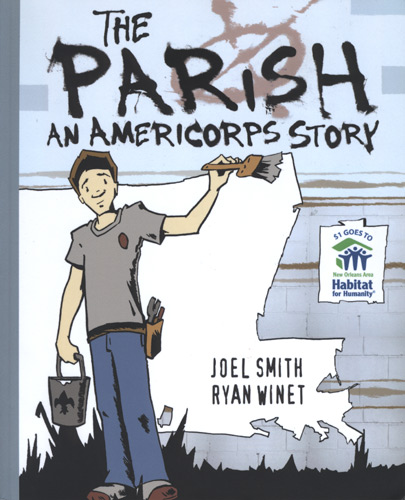The Parish
“This is not the story of Katrina, of flood waters rising and then receding,” the prologue of The Parish: An AmeriCorps Story lets readers know. One could argue that it’s not even “An AmeriCorps Story” either. The Parish is a story of finding purpose and direction in a place that feels devoid of nearly everything—a story of finding purpose and direction in one’s self. “This is not the story of Katrina, of flood waters rising and then receding,” the prologue of The Parish: An AmeriCorps Story lets readers know. One could argue that it’s not even “An AmeriCorps Story” either. The Parish is a story of finding purpose and direction in a place that feels devoid of nearly everything—a story of finding purpose and direction in one’s self.
Illustrated by Ryan Winet, written by Joel Smith, and inspired by his own times spent in AmeriCorps, the graphic novel follows Leo and his cast of friends as they arrive at St. Bernard’s Parish, Louisiana a year after Hurricane Katrina. As an English major, Leo is assigned the task of writing for The Heat, the camp newspaper, though he doubts his work:
It was like living in the land time forgot. Or maybe with all the water in the air and the promise of more to come, it was like living in a time that land forgot. Who was I to preserve the parish in print? I felt like a fraud, a carpetbagger.
And when he’s not thinking over the lack of work at The Heat, Leo’s thoughts are on Kiley, the resident cute girl wholly dedicated to working as hard as she can out in the parish.
Smith paces his story well, allowing his characters to evolve and show new parts of themselves as the graphic novel progresses. Changes can especially be seen in Leo, his character growing and finding himself as time goes by. Care even goes into the minor characters, from Boz, the camp’s head cook, to Wayne, the camp director who seems more interested in making the covers of magazines than doing good for the community. Paired with Winet’s visual renderings, the characters are all well-fleshed out despite the relatively short length of the book.
Beyond the characters, Winet’s illustrations are stark and simple, fitting the setting perfectly. Scenes of the buildings, the ruin, and the levees are all the strongest in the book and pair well with Smith’s writing which is as blunt and poetic as the drawings. Leo’s inner narrative is honest and somewhat innocent, an illustrated journal of even his more selfish personal thoughts.
Published at the beginning of hurricane season, Beating Windward Press takes this homage one step further:
A limited “un-damaged” edition of The Parish: An AmeriCorps Story was published on June 1, 2015 with clean black and white interior pages. On August 29, 2015, the tenth anniversary of Hurricane Katrina, the limited first edition will be discontinued and a color, “storm-damaged” edition will replace the first.
What was already an interesting concept to me—reading a graphic novel in a real-world setting about something I remember watching on the news—has become even more compelling with this creative twist. While this graphic novel won’t be everyone’s cup of tea, it’s an entertaining read and supports a good cause: with each copy sold, the publisher donates a dollar to the New Orleans Area Habitat for Humanity.
The Parish provides a quick glimpse at development amidst rubble, and not just the rebuilding of homes, but the building of character as well. Not only an AmeriCorps Story, it’s a story about finding one’s place and one’s worth, of learning when to put aside the self when it matters the most.





